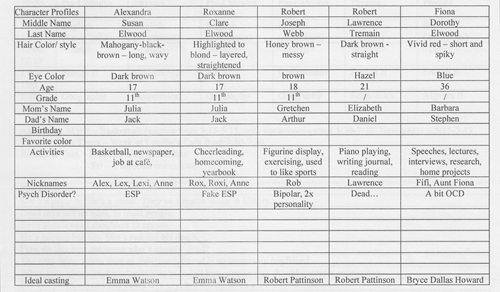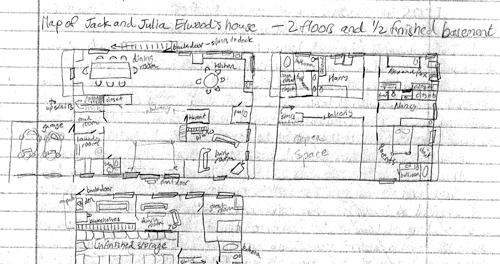Acting with Tables for Inventing Fan Novels
Alexandra also acts with tables as she plans, drafts, and revises the fan novels she has been writing since her childhood. Like Kate, fan fiction writing was a central part of Alexandra’s youth that has continued into the present. Alexandra’s fan writing began with a book she wrote at age eight based loosely on a Laura Ingalls Wilder novel she had been reading at the time. Since that initial novel, Alexandra has written seven additional others, many of which have undergone multiple rounds of substantial reorganization and revision over the years. She has submitted three of these novels for publication, but as of 2013 had not received any acceptances. Since 2010, Alexandra had been working on five of her novels, including Phantom, the first book of a trilogy she plans to write based on the Twilight novels and films, and Shepherd’s Banner, which is based on The Lord of the Rings and has a religious theme.
In this brief video clip (below) constructed from one of our interviews, Alexandra discusses some of the tables and other inscriptions that inform her work on Phantom.
In the opening portion of the video, Alexandra's mention of "the character one" is a reference to the initial handwritten table she created to generate and record key details about the characters in Phantom. As an essential first step in Alexandra's invention process, these handwritten character tables, which she also refers to as "character profile sheets" or just "character sheets," are the first documents she creates in her notebook as she begins work on each new fan novel. In the video, Alexandra describes laying out the initial handwritten version of the character sheet for Phantom by drawing vertical lines through the existing horizontal lines on a page of her notebook. Having created a series of columns and rows, Alexandra then labeled the cells in the far-left column to designate rows for details about the Phantom's characters, including their first, middle, and last names, their hair colors, and so on. As she indicates in the video, the character sheet helps Alexandra keep track of the minute details of each character in the novel.
While Alexandra created the initial character profile sheet for Phantom by hand in her notebook, she created later versions using the table function in Word documents. The character sheet above (see Figure 9) was included among the host of other documents Alexandra shared as samples of the inscriptions she used to develop Phantom's characters and plot (scroll through Figure 9 to view other tables Alexandra created and used, including a table containing details for Phantom's minor characters; characters' class schedules; "tag lines" associated with key portions of the novel; and songs associated with each chapter. We will discuss many of these inscriptions later in this section, and examine Alexandra's tables of songs in the next section of this chapter). Working from the initial handwritten version, Alexandra used headings across the top of this version to indicate the novel's major characters, and headings down the left-hand side to indicate important details, including middle and last name, hair color and style, eye color, age, grade, mothers’ and fathers’ names, and so on, and then filled in the cells with each character's information. In addition to indicating the ideal celebrity to play each character should the novel get turned into a movie, the Word version of the character sheet also features a number of blank rows for any additional details Alexandra might wish to include as her work on the novel moved forward. Alexandra drew upon a variety of sources to locate the details she needed for each character. She borrowed many of the characters' names, for example, from a book of popular baby names from 1982. Other details were drawn from her own life, such as the some of the characters’ activities, which echo the pastimes and hobbies that she and her family members were involved in.
In the same way that the columns for the weekly pages of her schedule planner are contingent upon her commitments for a particular semester, the number and headings of columns for the character profile tables are contingent upon the novel she is working on. The character profile table for her spin-off of Pride and Prejudice, for example, includes a column for each character’s personality. The profile table for her Shepherd’s Banner novel, on the other hand, includes columns for characters’ gender, occupation, meaning of their names, and their role in the story.
As Alexandra indicates in the video, and as evidenced in the documents she shared (see Figure 9 above), other kinds of tables mediate her fan writing for Phantom. One of the tables she mentioned during the video, for example, consisted of some of the characters' high school class schedules, which Alexandra indicated was essential for helping her know where those characters were throughout the school day and when multiple characters might be together in the same class. The chapter-by-chapter "summary" Alexandra mentioned in the video also took the form of a table listing the number and title of each chapter in one column and a brief description of the chapter's main scenes in another. This "summary" table consisted of the first two left-hand columns of the table titled "Outline and Music for PHANTOM" (see Figure 9 above). Those two columns were incorporated into the larger table later as Alexandra started listing the songs she associated with each chapter. In addition to the table containing information for the novel's major characters, Alexandra also created a more concise table for details about the many minor characters she developed as her work on Phantom progressed. Alexandra also generated a simple table to record the various "tag lines," brief memorable phrases that poignantly evoke a particular scene, she came up with to underscore key events in the novel.
Alexandra’s notebooks for some of her other fan novels included an even wider variety of tables. For her Shepherd’s Banner fan novel, she created multiple tables indicating the translations for key words in the language she developed for the book, and multiple tables detailing key characteristics of the spears used by the book's main characters. Alexandra indicated that she also incorporated tables into some of her other fan activities. She stated, for example, that, “My sister and I used to do live fan fiction. We would make these huge charts with all the characters we could be from different Star Trek episodes, and then we would act out our own episodes.”
As numerous and varied as they are, tables are only part of the cascade of inscriptions animating Alexandra’s fan novel writing. In addition to the family tree diagram she created (see Figure 9 above), her folder for Phantom also contained a hand-drawn floor plan of the main character's house (see Figure 10 at the right). It also included samples of cover art and illustrations of key scenes Alexandra created by using photo editing software to manipulate images from the Twilight novels and other sources she located on the web. In one illustration, Alexandra expertly pasted the faces of the male and female protagonists from the Twilight movies onto figures dressed in flowing robes, and then pasted the lyrics from two romantic songs above each of their heads. Alexandra generated these types of inscriptions for her other fan novels as well. Her notebook for Shepherd’s Banner, for example, included a host of hand drawn maps of the different territories the characters traversed and penciled drawings of characters’ clothing and weapons.
The tables Alexandra acts with as she invents, arranges, and drafts her fan novels allow her to see and order the world from the perspective of a fan novelist. The character profile tables, for example, provide a means of selecting from, simplifying, and ordering details about the characters from almost innumerable possibilities. And yet, they also serve many of the same functions as those she acts with for her engineering activities. As memory aids, the character profile tables offer a means of “keeping track of things,” as Alexandra mentions in the video, while drafting and revising multiple novels over lengthy periods of time. The tables also work to select from and coordinate a variety of other inscriptions. The character profile table for Phantom, for example, selects from and coordinates the book of baby names Alexandra uses and the lived activities of Alexandra and her family members. In turn, the character profile table is assembled into other inscriptions. As she drafts her novels, Alexandra draws upon the character profile table and the other inscriptions as she checks details about the characters or reminds herself which class they might be attending or where in the house they might be inhabiting during a particular scene.
Our analysis of the various tables associated with Alexandra's fan writing continues in the next section, where we focus our attention the tables she employs to invent and arrange soundtracks for her novels.


